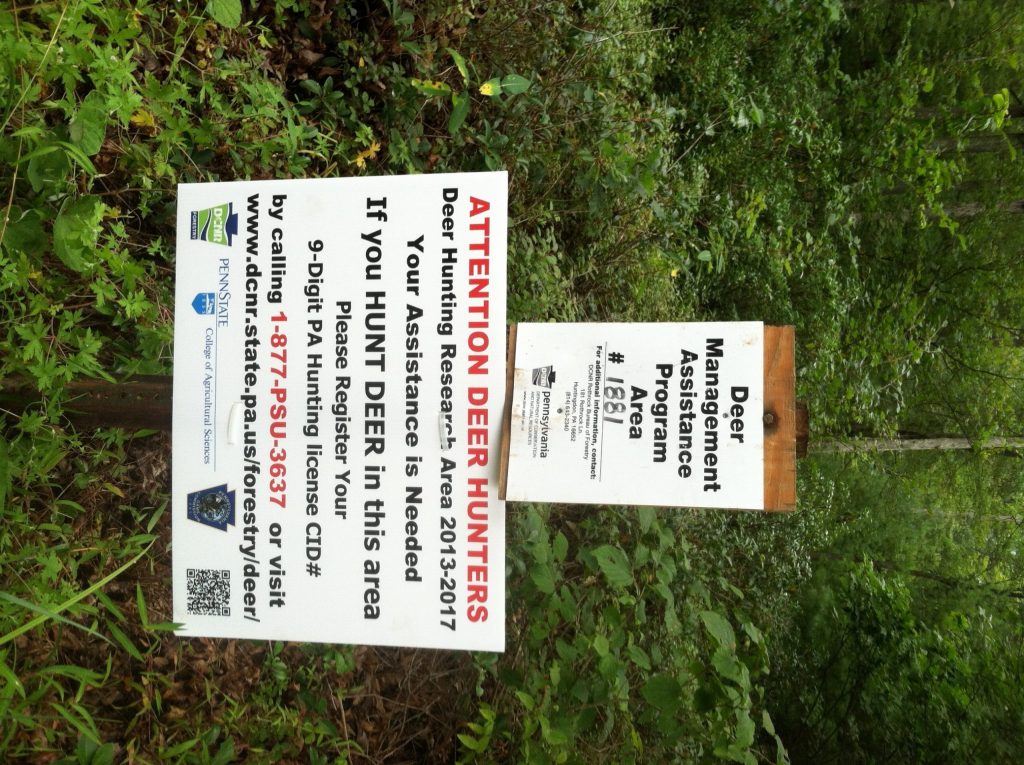Consider this. It’s the first day of archery season and you just settled into your tree stand and pretty soon you hear “crunch, crunch, crunch” through the leaves and the sound keeps getting closer. Your senses are suddenly fully alert – you try to tell your heart to stop racing and your lungs to slow their breathing. Oh, the anticipation!
Will it be that big buck you have seen on your game camera, or a doe? And then, to your left. A deer steps out from behind the brush and you can see that it’s a nice 6-point. He’s definitely legal but is he big enough in your book? Should you pass and wait – you have all season!
And then you notice the radio-collar around his neck. You think back to the all the signs posted about deer research in the area. Is it legal to shoot a collared deer? You should have paid closer attention to those signs!
What would you do? Shoot it? Let it pass because you are waiting for a bigger buck? Pass because you’re not sure if it’s legal to shoot collared deer? Maybe you pass because you think the researchers might learn more if he lives.
These questions are not trivial! How hunters respond to collared deer is critical to deer research in North America. if hunters avoid shooting collared deer then estimates of harvest rates will be too low. If they target collared deer, as if they are trophies, then harvest rate estimates will be too high.
To be honest, not a lot of research has been done to answer these questions even though millions of dollars have been spent collaring deer to estimate harvest rates. In Wisconsin, some researchers tried to find out with a cleverly-designed experiment. They had both novice and experienced hunters sit in tree stands for a set amount of time. The researchers placed full mounts of deer within view (maybe partially hidden by vegetation), of which some had radio-collars and others did not. After their “hunt”, the hunters were asked if they saw the deer, if it had a radiocollar, and whether they would have harvested the deer.
What the researchers found was that the larger the antlers the more willing hunters were to harvest the deer. And experienced hunters were more willing to harvest the deer than novice hunters. The researchers suggested that radiocollars might influence whether hunters shoot a deer and that could place doubt on conclusions about harvest rates.
So we designed a study to find out whether collars influenced hunters in Pennsylvania. We monitored deer that had visible radio-collars, or $100 reward ear tags that were nearly invisible until a deer was harvested, or small radio-transmitters attached to ear tags that were also difficult to detect from a distance. We had 3 separate field experiments – one with bucks and ear-tag transmitters, a second with bucks and reward tags, and a third with doe and reward tags.
What did we predict? Well, based on the Wisconsin study and our own survey of hunters, we predicted no difference in harvest rates between ear-tagged and collared doe. For the bucks we predicted that older bucks (presumably those deer with larger racks) would be more likely to be harvested even if they had a collar.
What did we find? Well, in one buck study we found no effect of collars on harvest rates. In the doe study we found no effect of collars on harvest rates, and in the other buck study we found that younger, collared bucks were more likely to be harvested. Go figure!
Now consider this. It’s the last week of rifle season. You have been hunting hard this year, since archery opened, and never had a buck come within range to get a shot. You hear that “crunch, crunch, crunch” and out steps that 6-point buck with a radio-collar. Do you shoot?
We concluded from our research that we have no evidence that putting collars on deer influences hunter behavior in any predictable way. It’s all context dependent. And even though hunters may tell you what they INTEND to do, no one ever really knows until they’re faced with a real decision.
So are there instances when hunters pass on a collared deer because they’re not sure if it’s legal? Definitely. Do some harvest a collared deer because it’s a new type of trophy. For sure. But overall, we haven’t been able to match self-described hunter intentions with actual hunter behavior in any consistent manner when it comes to harvesting collared deer. That means we have confidence in our estimates of harvest rates on deer in Pennsylvania.
And that’s good, because collared deer are an important tool of wildlife biologists for studying deer behavior – and hunter behavior!
-Duane Diefenbach
P.S. In case you’re still not sure, we always tell hunters that if you are hunting and see a collared deer that is legal for you to harvest, don’t let the collar sway your decision. Happy hunting!
If you would like to receive email alerts of new blog posts, subscribe here.
And Follow us on Twitter @WTDresearch
